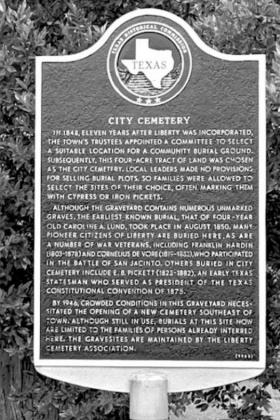City Cemetery
In a meeting of the Trustees of the Town of Liberty on 27th May 1848, it was ordered that a committee of three be appointed “to select a suitable lot for a berying (sic) ground.” On that date it was further ordered that W. H. Huggins, George W. Miles and H. Jackson be appointed to said committee. It is unknown exactly when the site for a “burying ground” was selected by the committee but probably within the same year of 1848.
The Trustees never made provision for the sale of grave plots, so the title is still vested in the City of Liberty. Early custom was to permit the citizens of the town to select and mark a family burial plot. During the years of open range when it was common for livestock to roam freely, the town trustees worked to keep the cemetery enclosed with a rail or picket fence to prevent livestock from desecrating the graves and destroying grave markers. In later years, fencing of individual family plots became the custom. This was achieved with cypress pickets, later iron fencing and much later chain link wire. There are only a few family plots now enclosed with fencing.
The earliest known “marked” grave was that of Caroline A. Lund, born 27th September 1845 and who died 4th August 1850. She was the daughter of Charles C. Lund, a native of Denmark and his wife, Mary. He was a Liberty merchant and town trustee in 1848 and 1849. However, an earlier burial was alluded to in a handwritten account of the Runaway Scrape authored by Dilue Rose Harris (1825-1914) and written in 1899 and later published in the Southwestern Historical Quarterly, an early historical journal of the Texas State Historical Association. The document recorded her childhood memories of the Texas Revolution and the exodus known as the Runaway Scrape after the fall of the Alamo when hundreds of families fled their homes heading eastward to the Sabine River fearing the advancing Mexican army. Mrs. Harris recounted the horror of their hasty escape and obstacles such as crossing river with supplies in wagons with teams of horses, injuries, and disease. Many of the women and children were ill with measles, fevers, and other contagions as well as suffering from lack of food and water as they approached the flooded Trinity River and Liberty. The family decided to camp near Liberty for a few days and the citizens wee welcoming and helpful. Mrs. Harris recalled her little sister had been extremely ill as they made camp. She later “died and was buried in the cemetery at Liberty.” From this first-hand account along with other documents which indicate a graveyard was established in Liberty, perhaps informally, prior to 1848. This child could have been the first burial in April of 1836.
There are currently over 700 recorded interments in this burial ground, and it is one of the oldest cemeteries in Liberty County with many graves dating prior to the 1870s and containing within its boundaries many pioneer citizens.
Among those interred in City Cemetery are veterans of six (6) wars. Franklin Hardin (1803-1878) participated in the Siege of Bexar (1835) and both he and Cornelius DeVore (1819- 1883) participated in the Battle of San Jacinto (1836). James Madison Hall (1819-1866) and E. B. Pickett (1823-1882) served in the Mexican War (1846-1848) and E. B. Pickett, B. F. Cameron (1841-1914), L. C. “Clay” Chambers (1842-1918), Thomas J. Chambers (1840-1929), Ephraim Jesse Crain (1837- 1905), Philip DeBat (1828-1889), William B. Duncan (1818-1867), William F. Hardin (1841-1908), W. S. Jones (1839-1915), Robert J. Love (1833-1870), John McMillen (1841-1904), William F. McNair (1837-1918), Baldwin O’Callahan (1839-1868), James A. Partlow (2840-196), Thomas B. Smith (1834-1907), Walter B. Taylor (1841-1887), S. S. Woodworth (1833-1884), and Hardin Wright (1840-1906), served in the Civil War (1861-1865). It is likely additional veterans of the Civil War are interred in this old cemetery in graves which are unmarked. Early journals and letters indicate the burial of other Civil War veterans “at Liberty” in ceremonies conducted by the Masonic Lodge. This would exclude the Catholic Cemetery and the Protestant Cemetery was the only “public” cemetery in use in Liberty during this period.
James S. Bailey (1879-1932) and Gus Hardin (1869-1933) participated in the Spanish American War (1898). There are many veterans of World War I (1917-1918) and World War II (1941-1945) interred in City Cemetery.
Due to crowded conditions in the cemetery, in 1946 burials were restricted by City Ordinance to the families of persons already interred there if space is available. The cemetery is maintained by the Liberty Cemetery Association and in more recent years, a perpetual care trust fund was established with funds contributed by the descendants of those interred in the cemetery to provide for the maintenance in perpetuity.
In 2017, the Liberty County Historical Commission applied for and received an Historic Texas Cemetery designation from the Texas Historical Commission honoring this early cemetery.

